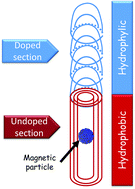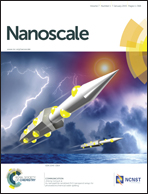Magnetic amphiphilic hybrid carbon nanotubes containing N-doped and undoped sections: powerful tensioactive nanostructures†
Abstract
In this work, unique amphiphilic magnetic hybrid carbon nanotubes (CNTs) are synthesized and used as tensioactive nanostructures in different applications. These CNTs interact very well with aqueous media due to the hydrophilic N-doped section, whereas the undoped hydrophobic one has strong affinity for organic molecules. The amphiphilic character combined with the magnetic properties of these CNTs opens the door to completely new and exciting applications in adsorption science and catalysis. These amphiphilic N-doped CNTs can also be used as powerful tensioactive emulsification structures. They can emulsify water/organic mixtures and by a simple magnetic separation the emulsion can be easily broken. We demonstrate the application of these CNTs in the efficient adsorption of various molecules, in addition to promoting biphasic processes in three different reactions, i.e. transesterification of soybean oil, quinoline extractive oxidation with H2O2 and a metal-catalyzed aqueous oxidation of heptanol with molecular oxygen.


 Please wait while we load your content...
Please wait while we load your content...